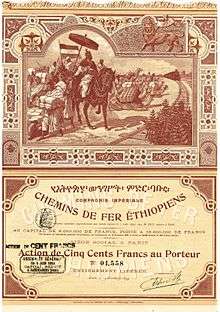Alfred Ilg
Alfred Ilg (30 March 1854 – 7 January 1916) was a Swiss engineer and a confidant to Ethiopian Emperor Menelik II. He was born in Frauenfeld, Switzerland.

Life
Alfred Ilg was sent to Ethiopia on behalf of a Swiss company in 1879 and served at the court of Emperor Menelik II (who became emperor in 1889), where he quickly learned the Amharic language. He contributed to the construction of the new capital of Ethiopia, Addis Ababa. The victory of Ethiopia over the invading Italians at the Battle of Adowa in 1896 can be tracked to his inventions, as his efforts allowed the local production of weapons and ammunition, freeing Ethiopia from the need of imports.
The emperor Menelik II rewarded Ilg with the title counselor in the range of an excellency in 1897 and, furthermore, named him minister of foreign affairs for the years 1897 to 1907. He showed his competence as an engineer when planning and implementing the railway line from Djibouti to the capital. He was also responsible for supervising the design and construction of the first piped water supply to the capital and for installing electrical power in the imperial palace in 1905.[2] Ilg was leading in the construction of several public buildings and worked as chef de protcolle and secretary for the emperor, receiving the highest medal available, the Star of Ethiopia.
Further achievements worth mentioning are the creation of a unified national currency system and the erection of a postal system. When Friedrich Rosen, an orientalist and leader of an official German delegation established several treaties between Ethiopia and Germany on 7 March 1905, Ilg's influence at court began to dwindle. He could not (or did not want to) do anything against several intrigues at court; which led to his resignation in 1907.
Alfred Ilg returned to Switzerland and settled in Zürich where he died at the age of 61.
Ilg was a contemporary of the French poet-turned-trader Arthur Rimbaud, and was his friend and frequent correspondent in East Africa.
References
- Galerie Sevogel: Historische Wertpapiere Volume 3. NZZ Verlag, 1984, pp 114-115 (ISBN 3-85823-108-8)
- Chris Prouty and Eugene Rosenfeld, Historical Directory of Ethiopia and Eritrea (Metuchen, NJ: Scarecrow Press, 1994), pp. 104-05, 171.
Bibliography
- Elisabeth Biasio: Prunk und Pracht am Hofe Menilek, Verl. NZZ, Zürich, 2004, ISBN 3-03823-089-8
- Conrad Keller: Alfred Ilg, sein Leben und sein Wirken als schweizerischer Kulturbote in Abessinien, Huber, Frauenfeld, 1918
- Heribert Küng: Staatsminister Alfred Ilg (1854–1916), ein Thurgauer am Hof Kaiser Menelik II. von Äthiopien, Thesis-Verl., Zürich, 1999, ISBN 3-908544-34-3
- Willi Loepfe: Alfred Ilg und die äthiopische Eisenbahn, Atlantis-Verl., Zürich, 1974, ISBN 3-7611-0446-4
- Bairu Tafla (Hrsg.): Ethiopian records of the Menelik era, Harrassowitz, Wiesbaden, 2000, ISBN 3-447-04258-3
- Hugues Fontaine: Un Train en Afrique. African Train. Centre Français des Études Éthiopiennes / Shama Books. Édition bilingue français / anglais. Traduction : Yves-Marie Stranger. Postface : Jean-Christophe Belliard. Avec des photographies de Matthieu Germain Lambert et Pierre Javelot. Addis Abeba, 2012, ISBN 978-99944-867-1-7.
Films
- Alfred Ilg - Der weiße Abessinier a film by Christoph Kühn (Switzerland, 2003)
External links
- Alfred Ilg in the German National Library catalogue